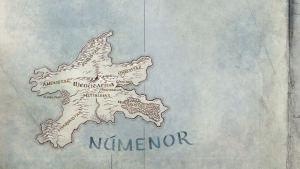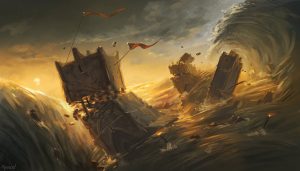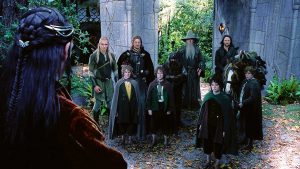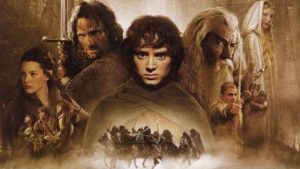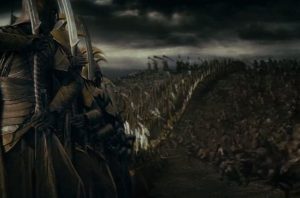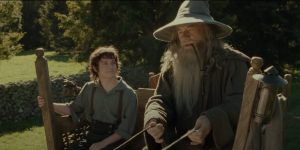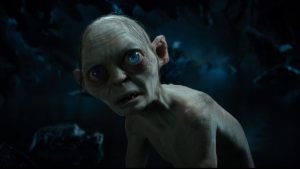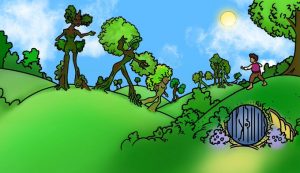The recent reveal of an official synopsis for Amazon Prime’s The Lord Of The Rings adaptation has left us all excited to jump back into Middle-earth and revel in the many joys it has to offer us. But to get fully prepared for Amazon’s upcoming series requires more than just a movie marathon or even a reread of J.R.R. Tolkien’s The Lord Of The Rings – Amazon is pulling from Tolkien’s extensive deep lore for their series, and diving into regions of Middle-earth previously unexplored by either the films or main books.
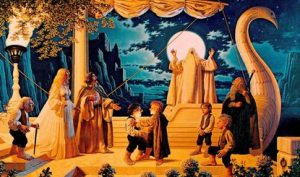
Lindon is by no means a name familiar to most Tolkien fans, so it’s understandable if you need a reminder about where it is in Middle-earth – though, in fact, both The Lord Of The Rings books and films did very briefly enter Lindon in the saga’s emotional climax. Described in Amazon’s synopsis as an “elf-capital” with “majestic forests”, Lindon is more recognizable as the Elven land west of the Shire where the Grey Havens were located…and from which Frodo and Bilbo set sail at the end of the Third Age, seeking out spiritual healing in the Uttermost West. This bit tends to be confusing for many first-time Tolkien fans, particularly movie-goers; the films don’t set it up as well as they should, and it never gets explained, leading to the entire sequence often being mistakenly interpreted as an allegory for Frodo dying.
But if you’ve ever wondered what happens to the Bagginses after they sail into the sunset at the end of The Return Of The King, then this is the post for you – and in the process, you’ll also learn everything you need to know about Lindon and its people before Amazon brings them to life on the small screen.
Amazon’s Middle-earth series, while still titled The Lord Of The Rings, is set thousands of years before the events of the trilogy, in the Second Age of Middle-earth during a time of mighty empires and epic heroes…but our story begins even further back, in the First Age. The world was flat like a tabletop, and still newly formed, and there were really only two continents: the westernmost of the two being Valinor, the land of the gods (or Valar, as they’re called in Tolkien’s myths), and the easternmost being…well, Middle-earth. The race of Elves originated in the uncharted forests of Middle-earth early in the First Age, predating the creation of the sun and moon by at least a millennia or two and explaining their collective fascination with stars, the only real source of light during their formative years as a species. The Valar had foreseen their coming, and what with the Elves being the subject of a whole bunch of prophecies, and a particularly nasty Dark Lord named Morgoth roaming through Middle-earth at the time, it was in everyone’s best interests for the Valar to herd the Elves westward, and over the sea into Valinor. Along the way, some Elves got fed up and went home, or got lost, or found other places to settle down…to keep things simple, I’m referring to those stragglers as Silvan Elves, though the proper blanket term for them is the Nandor. Anyway, remember them: they show up again later.
Of the Elves who made it all the way to Valinor and flourished there under the benevolent influence of the Valar, the most prominent and promising were always the skilled, hotheaded people known as the Noldor. But just three stolen gemstones and two dead trees later, Valinor had been plunged into chaos, and most of the Noldor recklessly took off for Middle-earth, pursuing Morgoth, the culprit, with an unholy vengeance in their hearts – all while openly rebelling against the Valar, who had insisted they stay put in Valinor while the gods dealt with Morgoth themselves. The Noldor established countries and civilizations of their own in Middle-earth, most of which toppled to ruin at the end of the First Age: when the Valar finally defeated Morgoth in battle, trampling mountains into the sea and flooding the entire region known as Beleriand until only a sliver of it remained; that sliver being Lindon, a coastal landmass just barely big enough to contain the entire suddenly displaced population of Beleriand – and not just the Elves, but the Men and Dwarves too.
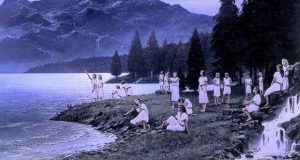
The Second Age opens with the Valar offering all of the exiled Noldor a chance to repent for their crimes and return to Valinor. Many Elves agreed to do so, but many more did not – instead choosing to stay in Middle-earth. Nonetheless, the option to sail back to Valinor was still available to all Elves at any time, and only made more accessible when Círdan the Shipwright completed building his Grey Havens in Lindon in the first year of the Second Age. But while Círdan presided over the Havens, he was never called a king – that title belonged to his adopted son, Gil-galad, who had become High King of the Noldor at a young age, and was by this point acknowledged as the highest-ranking Elven King in all of Middle-earth. Gil-galad stayed in Lindon even while many of his people migrated further eastward, settling new lands in Eregion and beyond.
Amazon’s description of Lindon as an “elf-capital” is both misleading (the closest thing to a city was the Grey Havens) and accurate, in a way: Lindon was a rural melting-pot populated by both Noldor and Silvan Elves, the latter of whom had lived there long before Gil-galad’s arrival. Tolkien hinted at the notion of a deep divide between the Elves from Valinor and those of Middle-earth, which I expect to see explored further in Amazon’s series; as the two peoples clash after their long estrangement, in a cultural and societal conflict. Meanwhile, Dwarves lived in the Blue Mountains that encircled Lindon – though their underground mansions of Nogrod and Belegost were both at least partially-destroyed by the turmoil of Morgoth’s fall.
Midway through the Second Age, Gil-galad warded off an attempt by the Dark Lord Sauron to infiltrate Lindon disguised as an emissary of the Valar named Annatar. Though Gil-galad could not guess at Annatar’s true identity, he sent warnings to his Elven kinsfolk across Middle-earth about the mysterious stranger – warnings that were ignored in Eregion, where Annatar was allowed to become a powerful and influential figure, overseeing the construction of all but three of the great Rings of Power. Those remaining three were secretly given to Gil-galad, Círdan, and Galadriel for safekeeping after Annatar betrayed the Elves of Eregion (*pretends to be shocked*), forging the One Ring to control them all.
Sauron’s brutality in Middle-earth drove many Elves back under the protective aegis of Gil-galad, whose power was still too great for Sauron to challenge – but some, out of fear and grief, fled across the sea to Valinor, never to return. Gil-galad brought in aid from Númenor to help conquer Sauron, unintentionally sparking a grudge-match between Sauron and the island kingdom of Men that eventually resulted in Númenor and most of its population being dragged into the ocean abyss; Valinor being removed from the Circles of the World by divine intervention (though still accessible via the “Straight Road” open only to Elven ships); and the earth being made round. Lindon lost many of its beaches, but otherwise scraped by.
In the final years of the Second Age, Lindon’s Elven armies played a pivotal part in bringing about the defeat of Sauron (albeit a temporary defeat). The last Númenórean refugees led by Elendil joined forces with Gil-galad’s Noldor and Silvan Elves in what became known as the Last Alliance, and together they pursued Sauron south across Middle-earth, into the mountains and volcanic wastelands of Mordor. There, on the slopes of Mount Doom, Gil-galad was burned to death by Sauron’s fiery hand: and with him died the kingship of the Noldor. His Ring of Power, Vilya, was saved by his young herald, Elrond, who later used it to heal Middle-earth’s hurts from his dwelling in the refuge of Rivendell. Lindon, meanwhile, faded in significance in the absence of its noble King, becoming little more than a rest stop on the one-way trip to paradise for world-weary Elves and occasional Ringbearers.
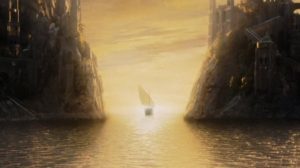
So next time you read the books or watch the movies, and get to those heart-wrenching final scenes at the Grey Havens, spare a thought for what was once the greatest realm of the Elves between the Mountains and the Sea in the Second Age – and think ahead to Amazon’s series, which will allow us to finally witness Lindon in all its glory.
Tell me what place in Middle-earth you’re most excited to see, and be sure to share your own thoughts, theories, and opinions, in the comments below!
